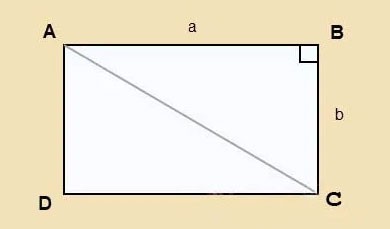The most commonly deficient nutrients in the diet

Diet is important to our health. Yet most of our meals are lacking in these six important nutrients.
How to calculate the diagonal of a square, how to calculate the diagonal of a rectangle is used a lot in math problems and practical applications such as design and construction, cutting corners, measuring... Quantrimang.com has compiled knowledge about the properties of two diagonals as well as calculation formulas, please refer to apply in study, life and work.
Table of Contents
The diagonal of a square or rectangle is a straight line connecting two opposite corners. Each square or rectangle has two diagonals of equal length.
According to the properties of a square, two diagonals of a square are equal and one diagonal of a square will divide the square into two parts of equal area, which are two isosceles right triangles. Thus, the diagonal of the square is the hypotenuse of the two isosceles right triangles.
So to calculate the diagonal of a square, you just need to apply the Pythagorean theorem to the right triangle.
Suppose you have square ABCD with side length a, diagonal AC divides the square into two right-angled triangles ABC and ACD.

Applying the Pythagorean theorem to the right isosceles triangle ABC:
⇒ ⇒
So the diagonal of a square has side length a:
Example 1: A square has a side of 3cm. Is the diagonal of the square: 6cm, √18cm, 5cm, or 4cm?
Solution:
a) Applying the Pythagorean theorem in square ABC, we have:
AC² = AB² + BC² = 3² + 3² = 18
=> AC = cm
So the diagonal of the square is √18 cm.
Example 2:
The diagonal of a square is 2dm. The side of the square is: 1cm, 3/2cm, √2cm or 4/3cm?
Prize:
Apply the Pythagorean theorem to the right triangle ABC, but this exercise gives the length of the diagonal, i.e. AC = 2cm, calculate side AB.
We have: AC² = AB² + BC² = 2AB (because AB = BC)
=> AB² = AC²/2 = 2²/2 = 2
=> AB = √2
A rectangle is a convex quadrilateral with four right angles, it is a parallelogram with two equal diagonals.
The diagonals of a rectangle have several important properties that are useful in solving problems involving rectangles and their diagonals.
From the properties of the diagonal of a rectangle above, we can use the Pythagorean theorem to calculate the length of the diagonal of a rectangle.
Suppose you have a rectangle ABCD with length a and width b, diagonal AC as shown below.

We apply the Pythagorean theorem to right triangle ABC:
⇒ ⇒
Therefore, the diagonal of a rectangle with length a and width b is:
So, the length of a diagonal of a rectangle is equal to the square root of the sum of the squares of the two sides (length and width) of the rectangle.
Thus, we can calculate the diagonal of a square or rectangle by simply applying the Pythagorean theorem.
Calculate the length of the diagonal of a rectangle with a length of 10dm and a width of 5dm.
Solution:
Let the length of the diagonal of the rectangle be a (a > 0, dm)
Applying the Pythagorean theorem, the length of the diagonal of the rectangle is:
a2 = 102 + 52 = 125
=> a = 5√5 dm
The properties and formula for calculating the diagonal of a rectangle can be applied to solve some problems proving that a quadrilateral is a rectangle.
Given quadrilateral ABCD with two diagonals perpendicular to each other. Let E, F, G, H be the midpoints of sides AB, BC, CD, AD respectively. What kind of shape is quadrilateral EFGH? Why?

Solution:
Because E is the midpoint of AB, H is the midpoint of AD
=> EH is the median of triangle ABD.
 (1)
(1)
Because F is the midpoint of BC, G is the midpoint of CD
=> FG is the median of triangle BCD
 (2)
(2)
From (1) and (2) =>

Consider the quadrilateral EFGH.
FG // EH
FG = EH
=> EFGH is a parallelogram (recognition sign)
On the other hand:

Also has:
E is the midpoint of AB, F is the midpoint of BC.
=> EF is the median of triangle ABC
=> EF // AC
But EH ⊥ AC => EH ⊥ EF

Parallelogram EFGH has a right angle
=> EFGH is a rectangle
Diet is important to our health. Yet most of our meals are lacking in these six important nutrients.
At first glance, AirPods look just like any other true wireless earbuds. But that all changed when a few little-known features were discovered.
In this article, we will guide you how to regain access to your hard drive when it fails. Let's follow along!
Dental floss is a common tool for cleaning teeth, however, not everyone knows how to use it properly. Below are instructions on how to use dental floss to clean teeth effectively.
Building muscle takes time and the right training, but its something anyone can do. Heres how to build muscle, according to experts.
In addition to regular exercise and not smoking, diet is one of the best ways to protect your heart. Here are the best diets for heart health.
The third trimester is often the most difficult time to sleep during pregnancy. Here are some ways to treat insomnia in the third trimester.
There are many ways to lose weight without changing anything in your diet. Here are some scientifically proven automatic weight loss or calorie-burning methods that anyone can use.
Apple has introduced iOS 26 – a major update with a brand new frosted glass design, smarter experiences, and improvements to familiar apps.
Yoga can provide many health benefits, including better sleep. Because yoga can be relaxing and restorative, its a great way to beat insomnia after a busy day.
The flower of the other shore is a unique flower, carrying many unique meanings. So what is the flower of the other shore, is the flower of the other shore real, what is the meaning and legend of the flower of the other shore?
Craving for snacks but afraid of gaining weight? Dont worry, lets explore together many types of weight loss snacks that are high in fiber, low in calories without making you try to starve yourself.
Prioritizing a consistent sleep schedule and evening routine can help improve the quality of your sleep. Heres what you need to know to stop tossing and turning at night.
Adding a printer to Windows 10 is simple, although the process for wired devices will be different than for wireless devices.
You want to have a beautiful, shiny, healthy nail quickly. The simple tips for beautiful nails below will be useful for you.













